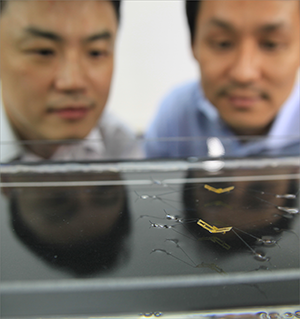Scientists and researchers from Seoul National University,Wyss Institute for Biologically Inspired Engineering at Harvard University and Harvard University John A. Paulson School of Engineering and Applied Sciences joined hands and has built a robotic insect that walks on and leap from water just the same way as Water-striders. The team's research gives us a better understanding of how this insect is able to perform such an ''unearthly'' act.
"Water's surface needs to be pressed at the right speed for an adequate amount of time, up to a certain depth, in order to achieve jumping," said the study's co–senior author Kyu Jin Cho, Associate Professor in the Department of Mechanical and Aerospace Engineering and Director of the Biorobotics Laboratory at Seoul National University. "The water strider is capable of doing all these things flawlessly."
The water strider, whose legs have slightly curved tips, employs a rotational leg movement to aid it its takeoff from the water’s surface, discovered co–senior author Ho–Young Kim who is Professor in SNU's Department of Mechanical and Aerospace Engineering and Director of SNU's Micro Fluid Mechanics Lab. Kim, a former Wyss Institute Visiting Scholar, worked with the study’s co–first author Eunjin Yang, a graduate researcher at SNU's Micro Fluid Mechanics lab, to collect water striders and take extensive videos of their movements to analyze the mechanics that enable the insects to skim on and jump off water's surface.
It took the team several trial and error attempts to fully understand the mechanics of the water strider, using robotic prototypes to test and shape their hypotheses.
"If you apply as much force as quickly as possible on water, the limbs will break through the surface and you won’t get anywhere," said Robert Wood, Ph.D., who is a co–author on the study, a Wyss Institute Core Faculty member, the Charles River Professor of Engineering and Applied Sciences at the Harvard Paulson School, and founder of the Harvard Microrobotics Lab.
But by studying water striders in comparison to iterative prototypes of their robotic insect, the SNU and Harvard team discovered that the best way to jump off of water is to maintain leg contact on the water for as long as possible during the jump motion.

|
| Adult water strider |
Mimicking these mechanics, the robotic insect built by the team can exert up to 16 times its own body weight on the water's surface without breaking through, and can do so without complicated controls. Many natural organisms such as the water strider can perform extreme styles of locomotion – such as flying, floating, swimming, or jumping on water – with great ease despite a lack of complex cognitive skills.
"This is due to their natural morphology," said Cho. "It is a form of embodied or physical intelligence, and we can learn from this kind of physical intelligence to build robots that are similarly capable of performing extreme maneuvers without highly–complex controls or artificial intelligence."
The robotic insect was built using a "torque reversal catapult mechanism" inspired by the way a flea jumps, which allows this kind of extreme locomotion without intelligent control. It was first reported by Cho, Wood and Koh in 2013 in the International Conference on Intelligent Robots and Systems.
For the robotic insect to jump off water, the lightweight catapult mechanism uses a burst of momentum coupled with limited thrust to propel the robot off the water without breaking the water's surface. An automatic triggering mechanism, built from composite materials and actuators, was employed to activate the catapult.
To produce the body of the robotic insect, "pop-up" manufacturing was used to create folded composite structures that self-assemble much like the foldable components that "pop–up" in 3D books. Devised by engineers at the Harvard Paulson School and the Wyss Institute, this ingenious layering and folding process enables the rapid fabrication of microrobots and a broad range of electromechanical devices.
"The resulting robotic insects can achieve the same momentum and height that could be generated during a rapid jump on firm ground – but instead can do so on water – by spreading out the jumping thrust over a longer amount of time and in sustaining prolonged contact with the water's surface," said Wood.
"This international collaboration of biologists and roboticists has not only looked into nature to develop a novel, semi–aquatic bio-inspired robot that performs a new extreme form of robotic locomotion, but has also provided us with new insights on the natural mechanics at play in water striders," said Wyss Institute Founding Director Donald Ingber, M.D., Ph.D.
Credit
